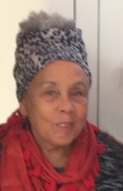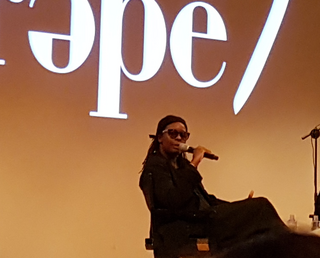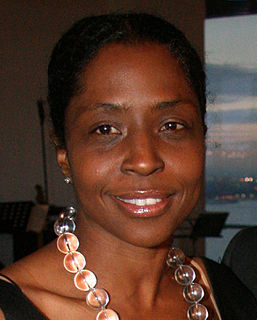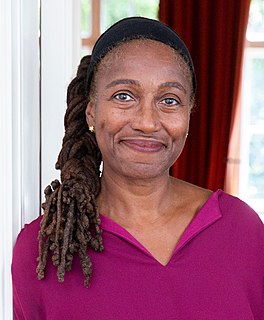Genevieve Gaignard | |
|---|---|
| Born | 1981 Orange, Massachusetts |
| Nationality | American |
| Education | Massachusetts College of Art and Design (2007), Yale University (2013) |
| Known for | Photography, Videography, Installation |
| Website | http://www.genevievegaignard.com/home |
Genevieve Gaignard, born in Orange, Massachusetts in 1981, is best known for work exploring issues of race, class, and gender. As a self-identified mixed-race woman, Gaignard utilizes photography, videography, and installation to explore the overlap of black and white America through staged environments and character performances. She received an AAS in Baking & Pastry Arts from Johnson & Wales University, her BA in photography from the Massachusetts College of Art and Design in 2007, and an MFA from Yale University in 2014. [1] Gaignard's work is represented by Susanne Vielmetter Los Angeles Projects, and has been shown at Shulamit Nazarian, The Cabin, The FLAG Art Foundation, The California African American Museum, The Foley Gallery, and at two residentially-owned art spaces in Los Angeles, CA. She was also included in the fourth iteration of the triennial Prospect New Orleans, in 2018, with an installation at the Ace Hotel New Orleans. Her work has been featured in The New York Times and The Los Angeles Times. Gaignard's photographic series draw inspiration from Carrie Mae Weems, Diane Arbus, Cindy Sherman, and Nikki S. Lee, remixed with the references to the selfie and Instagram culture. [2] [3] [4]
Born and raised in a Massachusetts mill town by a white mother and black father, Gaignard grew up between black and white cultures. Before enrolling at the Massachusetts College of Art and Design, Gaignard first enrolled at Johnson & Wales University in Providence, Rhode Island, in their baking and pastry program. She became interested in pursuing the arts after one of her professors became her mentor. Her professor created alternative assignments for Gaignard, reintroduced her to mediums such as collage, and opened Gaignard to experimentation in installation. According to Gaignard, she “went through this phase where Abercrombie & Fitch was really cool, I would rip pages out of the catalog and collage my whole wall with half naked guys.” [5] Gaignard began investigating racial dynamics with the use of composed environments and fabricated characters.
Gaignard began photographing her family and neighbors as she transitioned into the Massachusetts College of Art and Design. For a week of assignments “dealing with flesh,” Gaignard used her mother as a subject. [6]
Following her graduation in 2007, she applied to Yale University where she was wait-listed. Her anxiety surrounding her admission status motivated her to experiment with video art, where she created offbeat films. After she was eventually accepted, Gaignard transitioned back to photographic mediums with the added juxtaposition of installation. Yale's predominantly white student body contrasted sharply with the culturally diverse city of New Haven, prompting Gaignard to think through how to balance her two ethnicities. During her time at Yale, she began incorporating the intensity of race and storytelling in her work: “My expression as a person of color is different than others. I have something to say...The stuff I say now sort of addresses a lot of feelings I had as a child.” [7] It was through her exploration of race and family relations that she began creating personas staged in elaborate domestic interiors. [8]
As an emerging artist, Gaignard first garnered wider attention with her 2016 exhibition Smell the Roses at the California African American Museum in Los Angeles. The exhibition included a number of photographs of Gaignard dressed as a variety of characters alongside two elaborate room-sized installations, one of them a bedroom with a daybed covered in Cabbage Patch Kids dolls. Of the nine photographs featured in the exhibition, "Extra Value (After Venus)", shows Gaignard against a painted American flag holding a McDonald's cup and fries; another depicts Gaignard as a small-town housewife holding a watermelon in front of a discount store. [9]
Gaignard explores racial “passing” and gender to address the difficulties of being a mixed race woman in American society. [10] While Gaignard's work is said to be similar to Cindy Sherman and Carrie Mae Weems, she prefers not to be compared to them. Like Weems, Gaignard's works focuses on black female bodies and their place within society. [11] Gaignard's digital photographs utilize pop culture references and selfie culture to examine mixed race identity and black womanhood. [12] She consistently questions mass media and how it presents white and black cultures by pushing contrasts in her fictitious, femme characters.
Gaignard blends her digital photography with installations evoking the ideal family home. She states, “When I make an installation, I want it to be somewhere between a Wes Anderson film and Harmony Korine’s Gummo: gross and perfect at the same time but those are also super white references—so, that’s always my challenge.” [5]
Gaignard exaggerates elements of her personas, posing racial anxieties for viewers through parallel perspectives of her own self-identity. Although racial contrast is important to her characters and her overall work, Gaignard also blurs the lines between representations of black and white women by drawing on current and past pop culture references. [13] By blending representations, stereotypes, and taking inspiration from drag culture, she further challenges beauty standard norms, while also showing others the “invisibility” she faced growing up. [14]
Gaignard's work is in a number of public collections, including the Allen Memorial Art Museum, Nasher Museum of Art, California African American Museum, Pérez Art Museum Miami, Studio Museum in Harlem, and San Jose Museum of Art.
| Exhibit Name | Venue | Year | |
|---|---|---|---|
| 1 | Yale MFA First-Year Student Exhibition | Yale School of Art: Green Hall Gallery Location: New Haven, Connecticut | 2013 |
| 2 | Yale MFA Second-Year Student Exhibition | Yale School of Art: Green Hall Gallery Location: New Haven, Connecticut | 2013 |
| 3 | 13 Artists | Yale School of Art Location: New Haven, Connecticut | 2014 |
| 4 | Deep End Yale MFA Photography Thesis | Yale School of Art: Green Hall Gallery, The FLAG Art Foundation, Diane Rosenstein Gallery | 2014 |
| 5 | Shaq Loves People | Expose Chicago Note: Curated by Shaquille O'Neal Location: Chicago, Illinois | 2014 |
| 6 | The New New | Diane Rosenstein Gallery Location: Los Angeles, California | 2014 |
| 7 | Other Spaces | dc3 Location: Edmonton, Alberta, Canada | 2016 |
| 8 | Summer School | The FLAG Art Foundation Location: New York, New York | 2016 |
| 9 | Industry | dc3 Location: Edmonton, Alberta, Canada | 2017 |
| 10 | Comm | Alt | Shift | Aljira Center for Contemporary Art Location: Newark, New Jersey | 2017 |
| 11 | Face to Face: Los Angeles Collects Portraiture | California African American Museum Location: Los Angeles, California | 2017 |
| 12 | Fictions | Studio Museum Location: Harlem, New York | 2017 |
| 13 | Opening the Trap | Interface Gallery Location: San Francisco, California | 2018 |
| 14 | Forms & Alterations | 808 Gallery at Boston University Location: Boston, Massachusetts | 2018 |
| 15 | Fun House | Josh Lilley Gallery Location: London, United Kingdom | 2018 |
| 16 | Talisman in the Age of Difference | Stephen Friedman Gallery Location: London, United Kingdom | 2018 |
| 17 | In This Imperfect Present Moment | Seattle Art Museum | 2018 |
| 18 | People Get Ready | Nasher Museum of Art at Duke University Location: Durham, North Carolina | 2018 |
| 19 | Radically Ordinary: Scenes from Black Life in America Since 1968 | Allen Memorial Art Museum Location: Oberlin, Ohio | 2018 |
| 20 | Daegu Biennale | Daegu Location: Daegu, South Korea | 2018 |
| 21 | Personal Space | Crystal Bridges Museum of American Art Location:Bentonville, Arkansas | 2018 |
| 22 | Parallels and Peripheries | ArtCenter Location: Miami, Florida | 2018 |
| 23 | Terres de Femmes | Praz-Delavallade Location: Paris, France | 2018 |
| Exhibit Name | Venue | Year | |
|---|---|---|---|
| 1 | A Golden State of Mind | Diane Rosenstein Presents at The Cabin LA Location: Los Angeles, California | 2015 |
| 2 | Us Only | Shulamit Nazarian Location: Los Angeles, California | 2015 |
| 3 | Smell the Roses | California African American Museum Location: Los Angeles, California | 2016 |
| 4 | The Powder Room | Shulamit Nazarian Location: Los Angeles, California | 2017 |
| 5 | In Passing | Houston Center for Photography Location: Houston Texas | 2017 |
| 6 | Grassroots | Prospect 4 Location: New Orleans, Louisiana | 2017 |
| 7 | Hidden Fences | Praz-Delavallade Location: Paris, France | 2018 |
| 8 | Counterfeit Currency | The FLAG Art Foundation Location: New York, New York | 2018 |

Catherine Sue Opie is an American fine-art photographer and educator. She lives and works in West Adams, Los Angeles, as a professor of photography at University of California at Los Angeles (UCLA).
Barbara Kruger is an American conceptual artist and collagist associated with the Pictures Generation. She is most known for her collage style that consists of black-and-white photographs, overlaid with declarative captions, stated in white-on-red Futura Bold Oblique or Helvetica Ultra Condensed text. The phrases in her works often include pronouns such as "you", "your", "I", "we", and "they", addressing cultural constructions of power, identity, consumerism, and sexuality. Kruger's artistic mediums include photography, sculpture, graphic design, architecture, as well as video and audio installations.

Betye Irene Saar is an African-American artist known for her work in the medium of assemblage. Saar is a visual storyteller and an accomplished printmaker. Saar was a part of the Black Arts Movement in the 1970s, which engaged myths and stereotypes about race and femininity. Her work is considered highly political, as she challenged negative ideas about African Americans throughout her career; Saar is best known for her art work that critiques American racism toward Blacks.
Alison Saar is a Los Angeles, California based sculptor, mixed-media, and installation artist. Her artwork focuses on the African diaspora and black female identity and is influenced by African, Caribbean, and Latin American folk art and spirituality. Saar is well known for "transforming found objects to reflect themes of cultural and social identity, history, and religion."

Mickalene Thomas is a contemporary African-American visual artist best known as a painter of complex works using rhinestones, acrylic, and enamel. Thomas's collage work is inspired from popular art histories and movements, including Impressionism, Cubism, Dada and the Harlem Renaissance. Her work draws from Western art history, pop art and visual culture to examine ideas around femininity, beauty, race, sexuality, and gender.

Lorna Simpson is an American photographer and multimedia artist. She came to prominence in the 1980s and 1990s with artworks such as Guarded Conditions and Square Deal. Simpson is most well-known for her work in conceptual photography. Her works have been included in numerous exhibitions both nationally and internationally. She is best known for her photo-text installations, photo-collages, and films. Her early work raised questions about the nature of representation, identity, gender, race and history. Simpson continues to explore these themes in relation to memory and history in various media including photography, film, video, painting, drawing, audio, and sculpture.
Katy Grannan is an American photographer and filmmaker. She made the feature-length film, The Nine.
Carrie Mae Weems is an American artist working in text, fabric, audio, digital images and installation video, and is best known for her photography. She achieved prominence through her early 1990s photographic project The Kitchen Table Series. Her photographs, films and videos focus on serious issues facing African Americans today, including racism, sexism, politics and personal identity.

Renée Green is an American artist, writer, and filmmaker. Her pluralistic practice spans a broad range of media including sculpture, architecture, photography, prints, video, film, websites, and sound, which normally converge in highly layered and complex installations. She works to draw on cultural anthropology as well as social history, making her works well-researched and many times involving collaborators. Some of the topics she has covered include Sarah Baartman, the African slave trade, and hip hop in Germany.
Sarah Elizabeth Lewis is an associate professor of History of Art and Architecture and African and African-American studies at Harvard University. Her research focuses on the intersection of African American and Black Atlantic visual representation, racial justice, and representational democracy in the United States from the nineteenth century through the present.
Wendy White is an American artist from Deep River, Connecticut who lives and works in New York City.

Senga Nengudi is an African-American visual artist and curator. She is best known for her abstract sculptures that combine found objects and choreographed performance. She is part of a group of African-American avant-garde artists working in New York City and Los Angeles, from the 1960s and onward.

Sheila Pinkel is an American visual artist, activist and educator whose practice includes experimental light studies, photography, conceptual and graphic works, and public art. She first gained notice for cameraless photography begun in the 1970s that used light-sensitive emulsions and technologies to explore form; her later, socially conscious art combines research, data visualization, and documentary photography, making critical and ethical inquiries into the military-industrial complex and nuclear industry, consumption and incarceration patterns, and the effects of war on survivors, among other subjects. Writers identify an attempt to reveal the unseen—in nature and in culture—as a common thread in her work.

Shulamit Nazarian is a contemporary art gallery located in Los Angeles, California.
Sherin Guirguis is a visual artist based in Los Angeles, California. Guirguis has had solo exhibitions of her work at 18th Street Art Center, The Third Line Gallery (Dubai), Shulamit Nazarian Gallery, and LAXART. In 2012, Guirguis received the California Community Foundation Fellowship for Visual Artists and the 2014–15 City of Los Angeles Individual Artist Fellowship.
Anuradha Vikram is an art critic, curator, author, and lecturer based in Los Angeles, California. She is the artistic director of 18th Street Arts Center, Santa Monica, and a senior lecturer at Otis College of Art and Design, Los Angeles. She has contributed to numerous publications, and has a published book called Decolonizing Culture: Essays on the Intersection of Art and Politics.
Tomashi Jackson is an American multimedia artist working across painting, video, textiles and sculpture. Jackson was born in Houston, Texas, raised in Los Angeles, and currently lives and works in New York, NY and Cambridge, MA. Jackson was named a 2019 Whitney Biennial participating artist. Jackson also serves on the faculty for sculpture at Rhode Island School of Design. Her work is included in the collection of MOCA Los Angeles. In 2004, a 20-foot-high by 80-foot-long mural by Jackson entitled Evolution of a Community was unveiled in the Los Angeles neighborhood of West Adams.
Caitlin Cherry is an African-American painter, sculptor, and educator.
Amir H. Fallah (born 1979) is an Iranian-born American painter, publisher, sculptor, and installation artist. He was a founder of Beautiful/Decay magazine. He is based in Los Angeles, California.
J. Yolande Daniels is an American architect, designer and educator. She is a founding principal of studioSUMO, an architecture firm that speaks to socio-cultural landscapes through design.